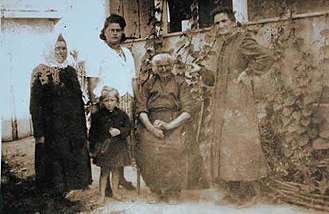Štivor
Štivor (Cyrillic alphabeth: Штивoр) is a village near Prnjavor (Bosnia), populated almost completely by Italians whose origins are from Sugana Valley (Italian-Valsugana) in the present autonomous province of Trentino, Northern Italy.

History
In the early 1880s because of heavy rains, the River Brenta flooded causing huge damage in the entire area of the Sugana Valley one of the most important valleys in the then Austrian province of Trentino. Damage to the structures were heavy, and many families were made homeless. The flooding affected the valley’s economy and the whole area entered an era of depression causing a loss of jobs. In a time of limited opportunities, rebuilding Trentino was a hard process. Those who had lost their homes and jobs, had to leave the area to survive. During the coming years, there were massive emigrations of Italians; many countries offered better alternatives than home. They considered as first option to go to Brazil, where the largest Italian community abroad was. However, after having sold all their remaining assets to pay out the travel fees, the villagers found out that the man in charge with the travel arrangement had disappeared with the money, defrauding them. Unconfirmed sources suggested that the news of what had happened to those hapless people, reached the Austro-Hungarian Kaiser Franz Joseph II, who moved by compassion, offered to settle them in the newly acquired province of Bosnia.
At the Congress of Berlin in 1878, the Austro-Hungarian Foreign Minister Gyula Andrássy obtained the occupation and administration of Bosnia and Herzegovina, a region which previously belonged to the Ottoman Empire, whose population was mainly Serbs, Croats and Bosniaks. Although the Province would not be formally incorporated into the Empire until 1908, the Imperial Government followed a policy of settling loyal populations in the region. In the Imperial vision this would have granted support to the Imperial policy in case of turmoil. At the time the province of Trentino was an integral part of the Austro-Hungarian Empire. Therefore, the Sugana Valley families from the villages of Primiero, Aldeno e Cimone, were given lands in Bosnia. After a month of travel around 320 families arrived in Bosnia and mainly settled in the districts of Prnjavor and Banja Luka, while others settled in Hercegovina in Konjica and Tuzla districts but the latter settlements would not last long. The Sugana families settled in the area in the village of Stivor toward the end of 1882. The newly arrived soon integrated into the new territory. With the dissolution of the Austro-Hungarian Empire in 1918, these ethnic Italians automatically became Yugoslavian citizens. Before the start of World War II the kingdoms of Yugoslavia and Italy negotiated an agreement regarding the Italian ethnic population living in the Yugoslav side of the Adriatic, and therefore the Italians living in the area were granted full Italian citizenship for a year, if they would have moved back to Italy, and lived there for a year. Many families took up the opportunity while many others opted to stay, especially the Trentini living in Stivor and Tuzla. (Some have argued that they were not well informed about the deal by the Yugoslav authorities, who were not anxious to show a large Italian presence in the area, which was considered to be entirely Slav.) However, as late as 1921 the number of the Italian living in the area was 292.
- After World War II
After the end of World War II farming remained the predominant economic activity in the area; in the mid-1960s the country's economy prospered considerably, and many inhabitants of Stivor moved to the Yugoslav industrial cities while others migrated abroad (most of them to Australia). When Tito’s Yugoslavia ended in 1991 and the war in Bosnia broke out, some of the Stivorians escaped abroad, and many of them reached the Trentino region, their ancestral home. Since then around 530 Stivorians have re-settled in Trentino, and on March 9, 1997 the, ”Circolo Trentini di Štivor” or, “ Stivorian-Trentinis’ Club” was founded in Roncegno in Trento province. To date around 270 persons of the original Italian community arrived in 1882 are still living in Stivor, BIH. They speak their original Trentino dialect, while the Italian language is taught at the local school, with a program supported by the World Trentine Association. (unsourced)
References
- Frizzera Sandra, "Stivor. Odissea della speranza", Bergamo, Ed. Innocenti, 1976.
- Lorenzi Guido, "Stivor, ritorno a casa", Trento, Ed. Innocenti,1980.
- Rosalio Maria Rita, "Studi sul dialetto trentino di Stivor (Bosnia)", Firenze, La nuova Italia, 1979.
- Toso Fiorenzo, "Lingue d’Europa. La pluralità linguistica dei Paesi europei tra passato e presente", Milano, Baldini Castoldi Dalai, 2006.
- Zardo Umberto, "Stivor: contributo alla conoscenza di una comunità italiana in Bosnia", Udine, Ed. Il loggione, 1978 •Zieger Antonio, "Storia del Trentino Alto-Adige", Trento, Ed. Monauni, 1926.